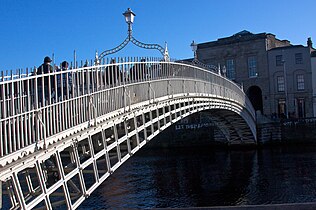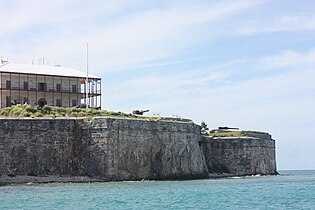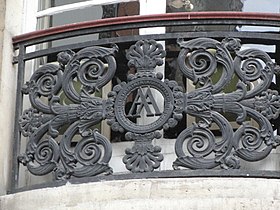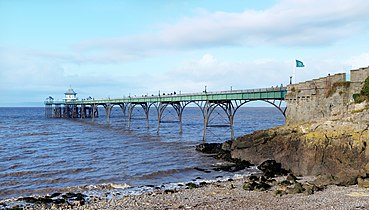Cast-iron architecture

Cast-iron architecture is the use of cast iron in buildings and objects, ranging from bridges and markets to warehouses, balconies and fences. Refinements developed during the Industrial Revolution in the late 18th century made cast iron relatively cheap and suitable for a range of uses, and by the mid-19th century it was common as a structural material (and sometimes for entire buildings), and particularly for elaborately patterned architectural elements such as fences and balconies, until it fell out of fashion after 1900 as a decorative material, and was replaced by modern steel and concrete for structural purposes.
Structural use
Cast iron is not a good structural material for handling tension or bending moments because of its brittleness and relatively low tensile strength compared to steel and wrought iron. However, cast iron does have good compressive strength and was successfully used for structural components that were largely in compression in well-designed bridges and buildings. In a few instances bridges and buildings built with cast iron failed when misused.
Cast iron was used as early as the 9th century in pagoda construction in Tang dynasty China.[1] Texts written by the Japanese Buddhist monk Ennin describe in detail the cast-iron pagodas and statues widespread in China at the time. Persecution of Buddhism in China in the 840's led to the destruction of many of these structures.[1] The later Song dynasty also built cast iron pagodas, exploiting its ability to be both structural and to be cast in any shape, such as in imitation of the timber and tiles of a standard pagoda. The 22m Iron Pagoda at the Yuquan Temple (Jade Springs Temple), Dangyang, Hubei, was built during the Song dynasty in 1061, and is the most outstanding example to survive. Cast iron pagodas were then superseded by even more elaborate bronze ones, but cast iron continued to be used for decorative items such as bowls and statues.
In Europe, it was in late 18th-century Britain that new production methods first allowed cast iron to be produced cheaply enough and in large enough quantities to regularly be used in large building projects. New production methods included using steam engine powered blast air, which allowed higher blast furnace temperatures, which in turn allowed the use of more limestone to be added with the iron ore charge. The higher furnace temperatures made the slag produced with the additional lime to flow more freely. The calcium and magnesium in the lime helped tie up sulfur, which allowed the use of coke for fuel. The higher furnace temperatures also increased the furnace capacity.[2]
Bridges

One of the first important projects was

Engineer
Another notable example is the elegant Ha'penny Bridge in Dublin, cast by the Coalbrookdale foundry, and built in 1816. The superior performance and greater spans of wrought-iron, and later wire suspension bridges, soon superseded cast iron for bridge construction.
Early use in buildings
Cast-iron columns for buildings had the advantage of being extremely slender, compared with masonry columns capable of supporting similar weight. That saved space in factories, and so after the five-storey 1795 Ditherington Flax Mill with its internal structure of cast-iron proved the concept, it became ubiquitous in the multi-level mills of northern England, and then across Europe and the United States, helping to fuel the Industrial Revolution. Its usefulness for multi storey buildings ensured it remained popular for all kinds of industrial and commercial structures, as well as supports for balconies in theatres and even in churches, up until it was finally replaced by steel in about 1900.
Cast iron was also taken up by some architects in the early 19th century where smaller supports or larger spans were required (and where wrought iron was too expensive), notably in the Royal Pavilion in Brighton, designed by John Nash and built between 1816 and 1823, where cast iron columns were used within the walls, as well as cast iron beams, to enable the construction of the decorative domes; the columns in the kitchens were disguised as palm trees.[3]
Roof frames
An elaborate cast iron frame was used for the dome of Saint Isaac's Cathedral in St Petersburg (1837–38), and the new roof following a fire of Chartes Cathedral (also 1837–8, and the widest span of a metal roof at the time). Similarly large span beams were also to support the wide roofs of the Palace of Westminster (1840s–50s).
Piers
Cast iron was also used as the principle support structure for seaside piers, with multiple slender columns able to support long decks of wrought iron and wood, and later large halls and pavilions; engineer
Use with wrought iron
Cast iron was not useful for items in tension like beams, where the more expensive wrought iron was preferred. Improvements in production saw the costs decrease at the same time as cast iron gained popularity. The puddling process, patented in 1784, was a relatively low cost method for producing a structural grade wrought iron. Puddled wrought iron was a much better structural material, and was preferred for bridges, rails, ships and building beams, and was often used in combination with cast iron, which was better in compression.
Steel
Steel was an even better structural material than wrought iron, and new steel making processes developed in the late 19th century[4] greatly lowered the cost of production to far below the cost of wrought iron.[4] The widespread use of cast-and-wrought iron frames in multi-level buildings was translated into steel-frame buildings, and was an essential step in the development of the modern skyscraper.
Architectural use
In Europe, cast iron had been occasionally used with architectural embellishment in the Middle Ages, such as fire backs with cast figures and scenes.[5] The improvements in techniques in the late 18th century led to the possibilities of finer castings, allowing decorative objects such as statuary and jewelry to be mass-produced. Following the development of the material as for structural purposes, it was soon adapted for uses that were both decorative and structural in all manner of buildings, structures and objects.
Early balustrades, railings and memorials

As soon as improvements in techniques led to finer castings, designers exploited the decorative possibilities. As early as 1775, noted architect Robert Adam joined with the Scottish Carron Company iron works to produce balcony railings in imitation of wrought iron, such as the railing for the Adelphi in London (a pattern that was still produced into the 1830s).[6] Another very early large scale example is the delicate fence of the Summer Garden in Saint Petersburg, designed by Georg Von Veldten, built between 1771 and 1784, which also imitated wrought iron, and is considered the pinnacle of cast iron design in the city. Other well known architects were early adopters of the material; John Nash employed cast iron as part of the structure of his landmark 1820s Royal Pavilion in Brighton, and German architect Karl Friedrich Schinkel was an enthusiastic early adopter, using cast iron for memorials such as the 20m tall Gothic Revival Kreuzberg War Memorial in 1821, and the delightful nautical seahorses and mermaids in the balustrade of the 1820s Castle Bridge in Berlin.

In Saint Petersburg, cast iron was used on the many bridges, sometimes as the supporting structure, but especially for the decorative railings and sculptural embellishments, including the chain-suspension 1826 Bank Bridge, with its distinctive cast iron griffin sculptures and elaborate balustrades, the 1840 Pevchesky Bridge, the 1842 Anichkov Bridge (a copy of the Berlin Castle Bridge), and more seahorses on the 1843–1850 Annunciation Bridge.
Prefabricated and transportable buildings
Since it could be used for all the structural members that would be cast in a foundry and then transported to site for erection, it was soon realised it could just as easily be transported anywhere in the world. The
An early type of completely prefabricated building was the large storage shed at dockyards. The Boat Shed (Number 78) at Sheerness Naval Dockyards, built 1856–60, is constructed entirely of a cast and wrought iron members, braced as portal frames, with extensive window and timber infill panels forming the external walls. Though not entirely of cast iron, it is the earliest large metal framed building still standing, and a pioneer in the development metal frames.[10]
Watson's Hotel in Mumbai was prefabricated in England and built in 1867–69, using brick infill panels in a heavy and decorative cast-iron frame and is the oldest completely cast iron framed building (as opposed to market or shed) in the world. Possibly the largest prefabricated cast iron structure is the Bulgarian St. Stephen Church in Istanbul, shipped out from Vienna in the late 1890s.
French use, integrated with decorative scheme

The Menier Chocolate Mill in Noisiel, completed in 1872, is often cited as the first building with an expressed metal frame. It was not however the first given earlier examples, but it is one of the most attractive (and some of the framing is hidden by the bricks). Designed by Jules Saulnier, it was an expression of a French approach that included an exposed metal frame as part of an overall decorative scheme, often using polychrome brick and tiles, with other examples later in date.
Verandahs and porches
The use of decorative cast iron as railings, fences and balconettes, then gradually gained popularity in Regency Britain and post-Napoleonic France as a cheaper alternative to the wrought-iron railings that only the wealthy could afford. The idea was exported to the colonies of both countries with hot climates as porches or verandahs, where it formed both decoration and structure.

New Orleans' French Quarter has the most famous and elaborate examples and the greatest concentration, with light, lacy often multi-level porches (known in New Orleans as galleries) on over 400 buildings, transforming the area from the 1850s to 1880s.[11] A few similar porches can be found in Savannah's Historic District, and the Church Hill and Jackson Ward neighborhoods in Richmond, though here it is mostly used for stair, porch and balcony railings. Numerous foundries in all three cities produced unique ornamental and structural designs in cast iron.

In Australia, similar porches of usually only one or two levels, known as verandas, decorated with 'cast-iron lace', became a standard feature, shading the fronts of nearly every house, terrace house, pub and shop from the 1850s into the 1900s.[12] Foundries in most cities and (with 42 in Melbourne alone[13]) and many country towns began by reproducing imported designs in the 1850s and then developing their own, sometimes featuring Australian fauna such as cockatoos and koalas,[14] but most featured flowing classically derived or vine-like patterns. After a period in the 1950s–60s when cast iron verandahs were routinely demolished,[15] since the late 1970s they made a revival, and numerous foundries still provide historic patterns to order.[16][17] Decorative cast iron used in a similar way can be found in other former British colonies including South Africa, Malaysia and India.
Cast-iron facades

In the 1840s the cheapness and malleability of cast iron led
Greenhouses, exhibitions and markets

Cast iron also became the standard support structure in the construction of larger
Cast iron was particularly useful to provide the entire structure of market halls, with a solid roof and open sides or highlight windows, and by the end of the 19th century nearly every new market in Europe (and most in Latin America) were cast-iron, some vast and elaborate, such as the 1850s Les Halles in Paris (demolished).
An interesting application is for a winter garden, with a solid roof but extensive glass walls, such as the Spa Colonnade in the spa town of Mariánské Lázně in the Czech Republic, built in 1889, which features an elaborate roof structure and extensive Neo-Baroque decorations in the facade, all in cast iron.
Arcades

Cast iron was quickly adapted to allow ever wider glass roofs on the then new idea of glass-roofed shopping arcades in Paris in the first decades of the 19th century. The idea spread across Europe and the United States in ever grander structures, and the largest examples had vast arched roofs in cast iron, such as the Galleria Vittorio Emmanuel in Milan.
Roofs, domes and atriums

Cast iron was used for the construction of large domes, as early as 1811 with the huge dome of the

The most famous example is the United States Capitol dome, built 1855–66 and made entirely of cast iron. The dome was designed by the architect Thomas Ustick Walter, and erected by the New York iron foundry, Janes, Fowler, Kirtland & Co. The dome consists of nearly 9 million pounds of cast iron.
The 1872 George Peabody Library in Baltimore is a similarly elaborate atrium with glass roof, where all the structural members are also decorative and made of cast iron. The lofty glass roof of Milan's Galleria, built 1865–77, is both a dome and glass roofed shopping arcade, the grandest ever built.[21] Later glass roofs such as that of the Grand Palais in Paris employed wrought iron or steel.
Cast iron lent itself to creating thinner supports in churches, an early example in 1837, when architect Louis Auguste Boileau supported the interior of the Eglise St-Eugene Ste-Cecile in Paris on slim cast iron columns and ribbed vaulting imitating the Gothic style, but thinner than stone would have allowed.
Two famous examples of cast iron as both support and decoration of a roof on slender columns are the two great mid 19thC libraries of
Street furniture and park items
Cast iron, a durable material that could take on any shape, was also popular from the mid 19th century for
For the same reasons, cast iron was also popular for structures within parks and gardens, both public and private, as well as on public promenades, used for fencing, seating, lamp posts, large fountains and drinking fountains, statues, decorative bridges, covered walkways, gazebos and bandstands. The 1885 Morisco Kiosk in Mexico City is a particularly elaborate example of the latter (though this may be wrought rather than cast iron). The 1870s Victoria Embankment in London features particularly ornate examples, with entwined dolphins supporting elaborate lampposts, and benches with sphinxes or camels as end panels.
Gallery
-
Pont Des Arts, Paris, 1804
-
Pontcysyllte aqueduct, North Wales, 1805
-
Ha'penny Bridge, Dublin, 1816
-
Commissioners House, Bermuda, 1820s
-
Cast iron balcony and railing, Arden House, Leamington Spa, England, 1832
-
Bourse de Commerce dome, Paris, 1811 (photo 1880s)
-
Kreuzberg Memorial, Berlin, 1821
-
Kitchen with palm tree cast iron columns, Royal Pavilion, Brighton, c. 1820
-
Sayn Foundry hall, Bendorf, Germany, 1830
-
Cast iron balcony, town hall, 9th arrondissement, Paris, c. 1830
-
St Isaac's Cathedral dome structure, c. 1838
-
Pevchesky Bridge, St Petersburg, 1840
-
Eisernes Haus, 1848, today part of Kunsthaus Graz
-
Bibliothèque Sainte-Genevieve, Paris, 1843–50
-
King Frederick Augustus Tower, Löbau, Germany 1852
-
Haughwout Building, Soho, NY, 1856-7
-
U.S. Capitol section, 1859
-
Salle Labrouste, Bibliothèque nationale de France, 1861–68
-
Watson's Hotel, Mumbai, 1869
-
Mercado Central, Santiago, Chile, 1869
-
Clevedon Pier, England, 1869, cast iron base structure
-
Sphinx bench, Victoria Embankment, London, 1877
-
Brighton Beach Bandstand, Brighton UK, 1884
-
Cast Iron building St Louis, Missouri
-
Cast iron fountain, Alexandra Park, Glasgow, 1901
-
Old cast-iron bench, Bad Kissingen, Germany
-
St Stephen's Bulgarian Church, Istanbul, 1898
-
Mikhailovsky Garden fence, St Petersburg, 1907
-
Lamps on Elgin Bridge (Singapore), 1929
-
TypicalWoollahra, New South Wales, late 19th century
References
Notes
- ^ a b Wertime, Theodore A. (1961). The Coming of the Ages of Steel. Leiden: E. J. Brill. p. 55.
- ISBN 978-0901462886.
- ^ "Royal Pavilion, Brighton". Engineering Timelines. Archived from the original on 2006-11-10. Retrieved 2019-12-28.
- ^ a b Landes (1969), pp. 91–93.
- ^ "Fireback". Victoria and Albert Museum. Retrieved 2023-01-20.
- ^ "Balcony Panel". Victoria and Albert Museum. Retrieved 2023-01-20.
- ^ "Map". Bermuda Maritime Museum. Archived from the original on March 29, 2010. Retrieved October 12, 2009.
- ^ Leseur, Paul A. (n.d.). "Restoration of the Commissioner's House". bermudamall.com. Archived from the original on 2008-12-03. Retrieved 2010-03-05.
- ^ "Corio Villa". Victorian Heritage Database. Retrieved 2023-01-20.
- ^ "Shed Number 78 the Boat Store Building Number 78". Historic England. Retrieved 2021-03-09.
- ^ Campanella, Richard (2018-12-08). "City Signature: Now a Mainstay, Iron-Lace Galleries Were a Long Time Coming to the Streets of New Orleans". NOLA.com. Retrieved 2019-10-25.
- ^ Lewis, Miles. "Ornamental Cast Iron" (PDF). Miles Lewis Australian Building.
- ^ Brown, Jenny (2011-07-30). "The City's Signature is Cast in Iron". Domain. Retrieved 2019-10-17.
- ^ "Origins of Lacework & Balustrade Designs". Chatterton Lacework. Retrieved 2019-10-17.
- ^ "Architectural elements, balustrade panels (7), cast iron lace, removed in 1970s from verandah of a house in Glebe, Sydney, New South Wales, Australia, made in Australia, 1880–1890". collection.maas.museum. Retrieved 2019-10-17.
- ^ "Lacework Designs" (PDF). Chatterton.
- ^ "- Cast Iron Lacework [L42C]". www.perrybirdpickets.com.au. Archived from the original on 2019-10-19. Retrieved 2019-10-17.
- ^ Gayle, Margot (1974). Cast Iron Architecture in America. New York: Dover Books.
- ^ Lee, Antoinette J. "Cast Iron Architecture". Encyclopedia of Greater Philadelphia. Retrieved 2022-03-13.
- ^ "J. B. Bunning's London Coal Exchange (1849)". www.victorianweb.org. Retrieved 2019-09-30.
- ^ "Galleria Vittorio Emanuele II (Milan, 1877)". Structurae. Retrieved 2020-02-18.
- ^ "The Story of Urban Light". Unframed. 2018-02-06. Retrieved 2019-11-17.
Bibliography
- Gloag, John and Bridgwater, Derek. A History of Cast Iron in Architecture, London: Allen and Unwin (1948)
- Landes, David. S. (1969). The Unbound Prometheus: Technological Change and Industrial Development in Western Europe from 1750 to the Present. Cambridge: Press Syndicate of the University of Cambridge. ISBN 0-521-09418-6.
- Lewis, Peter R. Beautiful Railway Bridge of the Silvery Tay: Reinvestigating the Tay Bridge Disaster of 1879, Tempus (2004) ISBN 0-7524-3160-9
- Lewis, Peter R. Disaster on the Dee: Robert Stephenson's Nemesis of 1847, Tempus (2007) ISBN 978-0-7524-4266-2
- Gayle, Margot. Cast Iron Architecture in America, Dover Books (1974)
External links
- Cast-iron architecture – The Columbia Encyclopedia, Sixth Edition.
- Glass, iron and prefabrication: AD 1837–1851 – History of Architecture
- John H. Lienhard (1993). The Engines of Our Ingenuity. Episode 836. NPR. KUHF-FM Houston. Iron Buildings.
- Victorian cast-iron buildings in Glasgow, Scotland
- Skidmore/Old Town National Historic Landmark
- The Maintenance and Repair of Architectural Cast Iron






























